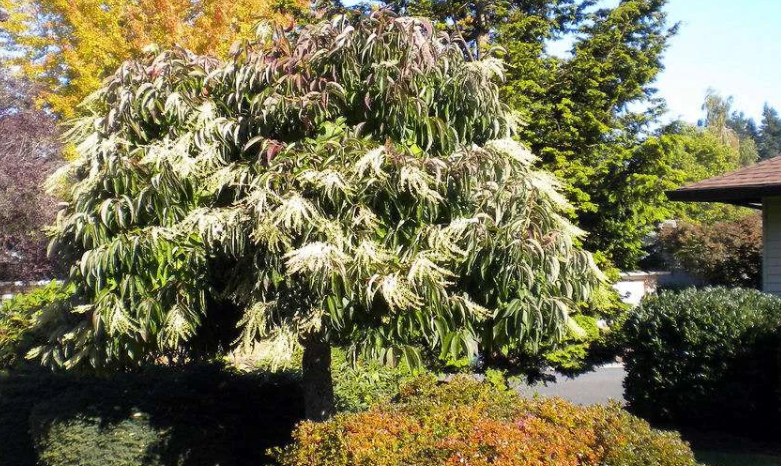
Oxydendrum arboreum, commonly called sourwood or sorrel tree, is a deciduous understory tree that is native to the eastern United States from Pennsylvania south to Florida and Louisiana. It is perhaps most commonly found on rocky wooded slopes in the Appalachian Mountains, often growing in combination with other heath family members (e.g., azaleas and rhododendrons) that share the same acidic soil preferences.
It generally has multiple seasons of interest, featuring glossy green leaves, tassels of bell-shaped, white flowers in summer, and spectacular autumn color. Even in winter, its deeply fissured dark gray bark stands out in the landscape. Sourwood trees grow 20-25 feet tall in cultivation, with a straight, slender trunk and narrow oblong crown. In the wild, they may reach 50-60 feet tall. These trees are hardy in USDA Zones 5-9 and thrive in cool, upland environments.
Characteristics of Sourwood Tree
- It grows to a height of 20 to 30 feet with a spread of 10 to 25 feet. The tree has a slender trunk and a narrow oblong crown, giving it a delicately pyramidal habit. Its branches are slightly pendulous and the growth rate is slow.
- It has alternate, finely toothed, glossy green leaves that are reminiscent of peach leaves. They measure 3 to 6 inches long. The leaves turn brilliant crimson-red to dark purple in the fall.
- The tree produces white, bell-shaped flowers that bloom in early summer. The flowers are borne in slender, drooping, one-sided terminal panicles that are 4 to 8 inches long. The flowers give way to 5-parted dry capsules that ripen to silver-gray in September.
- The bark is gray-brown and deeply ridged, with the ridges often divided into a somewhat square pattern. The branches are slender and the trunk is slender with a smooth texture.
- The root system is relatively shallow and fibrous, making it adaptable to a variety of soil conditions.
- The is hardy in USDA zones 5 to 9, which means it can be grown in states like Florida, Texas, and the Carolinas, as well as as far north as Iowa, Illinois, and New York State.
- Despite the tall stance of sourwood trees, they are a relatively short-lived, rarely exceeding 80 years.
- Sourwood trees prefer acidic, well-drained soil and full sun to partial shade.
- They are relatively drought-tolerant once established but benefit from supplemental watering during dry periods.
- Sourwood honey, produced by bees from the tree’s nectar, is highly prized for its unique flavor.
Common Problems Sourwood Tree
- Fall Webworm: This is an occasional pest that can defoliate portions of the Sourwood tree in summer and fall. The fall webworm (Hyphantria cunea) is a moth whose larvae feed on the leaves of the tree. While the damage may look alarming, it is usually not serious and control measures are often not needed.
- Twig Blight: This disease can cause leaves at the tips of branches to die. It is not a serious condition, but it is recommended to prune the infected branches and fertilize the tree to help it recover.
- Leaf Spot: This is a fungal disease that causes spots on the leaves. It is not usually serious, but it can make the tree look unsightly. Proper maintenance, such as cleaning up fallen leaves and avoiding overhead watering, can help prevent leaf spot.
- Deer and Rabbit Browsing: These trees are not particularly deer or rabbit resistant. Young trees, in particular, can be vulnerable to browsing, which can stunt their growth or even kill them.
- Pruning: Sourwood trees have a natural pyramidal shape, and they rarely need pruning. However, if they are planted in a location where vehicular or pedestrian clearance is needed, the drooping branches may need to be pruned.
- Soil and Moisture Requirements: Sourwood trees prefer well-drained, acidic soil. They are not highly drought tolerant, but they can grow in poor clay soils with no irrigation if the conditions are right. Overwatering can lead to issues like leaf spot.
- Sun Exposure: Sourwood trees can grow in full sun, part shade, or shade. However, they will produce more flowers and show better fall color in full sun. In deep shade, they may not flower as much and their fall color may be less vibrant.
- Temperature and Hardiness: These trees are hardy in USDA zones 5 through 9. They can grow in a wide range of climates, from Florida to New York State. However, they may struggle if planted outside of their hardiness zone.
- Pest and Disease Resistance: Sourwood trees are not known to be seriously affected by pests or diseases. They are generally considered to be low-maintenance trees.